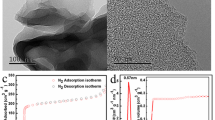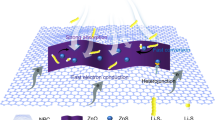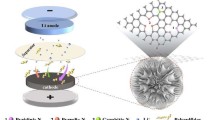Abstract
The intrinsic sluggish conversion kinetics and severe shuttle effect in lithium—sulfur (Li-S) batteries are responsible for their poor reversible capacity and cycling longevity, which have greatly hindered their practical applications. To address these drawbacks, herein, we design and construct a heterostructured Ni/Ni2P embedded in a mesoporous carbon nanosphere composite (Ni/Ni2P-MCN) for boosting polysulfide catalytic conversion in Li-S batteries. The Ni/Ni2P-MCN-modified separator could not only prevent the shuttle effect significantly through abundant chemical adsorptive sites, but also demonstrate superior catalytic reactivities for the conversion of polysulfides. More importantly, the conductive carbon matrix with an exposed mesoporous structure can serve as an effective physical barrier to accommodate deposited insoluble Li2S. Consequently, the cells with the Ni/Ni2P-MCN-modified separator exhibit greatly boosted rate capability (431 mA h g−1 at 5 C) and cycling stability (a capacity decay of 0.031% per cycle after 1500 cycles). Even at an enhanced sulfur loading of 4.2 mg cm−2, a stable and superior areal capacity (about 3.5 mA h cm−2) has been demonstrated. We envision that the unique Ni/Ni2P heterostructure in the porous carbon matrix could offer great potential for high-performance and sustained energy storage devices.

摘要
锂硫电池固有的缓慢转化动力学和严重的穿梭效应导致其可逆容量和循环寿命差, 严重阻碍了其实际应用. 为了解决这些问题, 我们设计并构建了一种Ni/Ni2P异质结嵌入介孔碳纳米球的复合材料(Ni/Ni2P-MCN), 将其用于锂硫电池隔膜改性以促进多硫化物的催化转化. 研究发现, Ni/Ni2P-MCN改性隔膜可以通过丰富的异质结化学吸附位点吸附多硫化物、抑制穿梭效应, 而且对多硫化物的转化具有优异的催化活性. 此外, 具有暴露介孔结构的导电碳球可以作为物理屏障, 容纳沉积的不溶性Li2S. 因此, 使用Ni/Ni2P-MCN改性隔膜的电池显示出优异的倍率性能(5C下431 mA h g−1)和循环稳定性(1500次循环下平均容量衰减约0.031%). 在4.2 mg cm−2的高载硫下, 输出面积比容量约3.5 mA h cm−2. 我们认为, 这种独特的Ni/Ni2P异质结/多孔碳复合材料在高性能、可持续储能器件中具备巨大的应用潜力.
Similar content being viewed by others
References
Huang S, Wang Z, Von Lim Y, et al. Recent advances in heterostructure engineering for lithium-sulfur batteries. Adv Energy Mater, 2021, 11: 2003689
Pang Q, Shyamsunder A, Narayanan B, et al. Tuning the electrolyte network structure to invoke quasi-solid state sulfur conversion and suppress lithium dendrite formation in Li-S batteries. Nat Energy, 2018, 3: 783–791
Service RF. Lithium-sulfur batteries poised for leap. Science, 2018, 359: 1080–1081
Yang T, Qian T, Liu J, et al. A new type of electrolyte system to suppress polysulfide dissolution for lithium-sulfur battery. ACS Nano, 2019, 13: 9067–9073
He Y, Qiao Y, Chang Z, et al. Developing a “polysulfide-phobic” strategy to restrain shuttle effect in lithium-sulfur batteries. Angew Chem, 2019, 131: 11900–11904
Xiao K, Wang J, Chen Z, et al. Improving polysulfides adsorption and redox kinetics by the Co4N nanoparticle/N-doped carbon composites for lithium-sulfur batteries. Small, 2019, 15: 1901454
Tang H, Li W, Pan L, et al. A robust, freestanding MXene-sulfur conductive paper for long-lifetime Li-S batteries. Adv Funct Mater, 2019, 29: 1901907
Kaiser MR, Chou S, Liu HK, et al. Structure-property relationships of organic electrolytes and their effects on Li/S battery performance. Adv Mater, 2017, 29: 1700449
Ma C, Feng Y, Liu X, et al. Dual-engineered separator for highly robust, all-climate lithium-sulfur batteries. Energy Storage Mater, 2020, 32: 46–54
Lei T, Chen W, Lv W, et al. Inhibiting polysulfide shuttling with a graphene composite separator for highly robust lithium-sulfur batteries. Joule, 2018, 2: 2091–2104
Pei F, Lin L, Fu A, et al. A two-dimensional porous carbon-modified separator for high-energy-density Li-S batteries. Joule, 2018, 2: 323–336
Pang Y, Wei J, Wang Y, et al. Synergetic protective effect of the ultralight MWCNTs/NCQDs modified separator for highly stable lithium-sulfur batteries. Adv Energy Mater, 2018, 8: 1702288
Jiang G, Zheng N, Chen X, et al. In-situ decoration of MOF-derived carbon on nitrogen-doped ultrathin MXene nanosheets to multi-functionalize separators for stable Li-S batteries. Chem Eng J, 2019, 373: 1309–1318
Fan X, Sun W, Meng F, et al. Advanced chemical strategies for lithium-sulfur batteries: A review. Green Energy Environ, 2018, 3: 2–19
Zhou G, Paek E, Hwang GS, et al. Long-life Li/polysulphide batteries with high sulphur loading enabled by lightweight three-dimensional nitrogen/sulphur-codoped graphene sponge. Nat Commun, 2015, 6: 7760
Guo P, Sun K, Shang X, et al. Nb2O5/RGO nanocomposite modified separators with robust polysulfide traps and catalytic centers for boosting performance of lithium-sulfur batteries. Small, 2019, 15: 1902363
Huang S, Lim YV, Zhang X, et al. Regulating the polysulfide redox conversion by iron phosphide nanocrystals for high-rate and ultrastable lithium-sulfur battery. Nano Energy, 2018, 51: 340–348
Yang JL, Zhao SX, Lu YM, et al. In-situ topochemical nitridation derivative MoO2-Mo2N binary nanobelts as multifunctional interlayer for fast-kinetic Li-sulfur batteries. Nano Energy, 2020, 68: 104356
Wang N, Chen B, Qin K, et al. Rational design of Co9S8/CoO heterostructures with well-defined interfaces for lithium sulfur batteries: A study of synergistic adsorption-electrocatalysis function. Nano Energy, 2019, 60: 332–339
Liu Y, Liu S, Wang Y, et al. Ru modulation effects in the synthesis of unique rod-like Ni@Ni2P-Ru heterostructures and their remarkable electrocatalytic hydrogen evolution performance. J Am Chem Soc, 2018, 140: 2731–2734
Tao X, Luo S, Tian C, et al. Ni@Ni2P encapsulation in interconnected N-doped carbonized cellulose nanofibril network for efficient oxygen evolution reaction. ACS Sustain Chem Eng, 2020, 8: 1859–1867
Yu Z, Wang B, Liao X, et al. Boosting polysulfide redox kinetics by graphene-supported Ni nanoparticles with carbon coating. Adv Energy Mater, 2020, 10: 2000907
Hou S, Xu X, Wang M, et al. Carbon-incorporated Janus-type Ni2P/Ni hollow spheres for high performance hybrid supercapacitors. J Mater Chem A, 2017, 5: 19054–19061
Zhang L, Liu D, Muhammad Z, et al. Single nickel atoms on nitrogen-doped graphene enabling enhanced kinetics of lithium-sulfur batteries. Adv Mater, 2019, 31: 1903955
Cheng J, Zhao D, Fan L, et al. Ultra-high rate Li-S batteries based on a novel conductive Ni2P yolk-shell material as the host for the S cathode. J Mater Chem A, 2017, 5: 14519–14524
Cheng J, Zhao D, Fan L, et al. A conductive Ni2P nanoporous composite with a 3D structure derived from a metal-organic framework for lithium-sulfur batteries. Chem Eur J, 2018, 24: 13253–13258
Mao J, Niu D, Jiang N, et al. Rational design of high nitrogen-doped and core-shell/mesoporous carbon nanospheres with high rate capability and cycling longevity for pseudocapacitive sodium storage. J Mater Chem A, 2020, 8: 9768–9775
Kang Y, Taton TA. Core/shell gold nanoparticles by self-assembly and crosslinking of micellar, block-copolymer shells. Angew Chem Int Ed, 2005, 44: 409–412
Wang Z, Xie Y, Li Y, et al. Tunable, metal-loaded polydopamine nanoparticles analyzed by magnetometry. Chem Mater, 2017, 29: 8195–8201
Lin Y, Yang L, Jiang H, et al. Boosted reactivity of ammonia borane dehydrogenation over Ni/Ni2P heterostructure. J Phys Chem Lett, 2019, 10: 1048–1054
Chen C, Jiang Q, Xu H, et al. Ni/SiO2/graphene-modified separator as a multifunctional polysulfide barrier for advanced lithium-sulfur batteries. Nano Energy, 2020, 76: 105033
Jiang H, Lin Y, Chen B, et al. Ternary interfacial superstructure enabling extraordinary hydrogen evolution electrocatalysis. Mater Today, 2018, 21: 602–610
Mendoza-Garcia A, Su D, Sun S. Sea urchin-like cobalt-iron phosphide as an active catalyst for oxygen evolution reaction. Nanoscale, 2016, 8: 3244–3247
Chang J, Feng L, Liu C, et al. An effective Pd-Ni2P/C anode catalyst for direct formic acid fuel cells. Angew Chem Int Ed, 2014, 53: 122–126
Chen T, Liu D, Lu W, et al. Three-dimensional Ni2P nanoarray: An efficient catalyst electrode for sensitive and selective nonenzymatic glucose sensing with high specificity. Anal Chem, 2016, 88: 7885–7889
Han A, Chen H, Sun Z, et al. High catalytic activity for water oxidation based on nanostructured nickel phosphide precursors. Chem Commun, 2015, 51: 11626–11629
Wang Q, Liu Z, Zhao H, et al. MOF-derived porous Ni2P nanosheets as novel bifunctional electrocatalysts for the hydrogen and oxygen evolution reactions. J Mater Chem A, 2018, 6: 18720–18727
Sun T, Zhang S, Xu L, et al. An efficient multifunctional hybrid electrocatalyst: Ni2P nanoparticles on MOF-derived Co,N-doped porous carbon polyhedrons for oxygen reduction and water splitting. Chem Commun, 2018, 54: 12101–12104
Lu X, Zhao C. Electrodeposition of hierarchically structured three-dimensional nickel-iron electrodes for efficient oxygen evolution at high current densities. Nat Commun, 2015, 6: 6616
Stern LA, Feng L, Song F, et al. Ni2P as a Janus catalyst for water splitting: The oxygen evolution activity of Ni2P nanoparticles. Energy Environ Sci, 2015, 8: 2347–2351
Peng CY, Kang L, Cao S, et al. Nanostructured Ni2P as a robust catalyst for the hydrolytic dehydrogenation of ammonia-borane. Angew Chem, 2015, 127: 15951–15955
Ou J, Zhang Y, Chen L, et al. Nitrogen-rich porous carbon derived from biomass as a high performance anode material for lithium ion batteries. J Mater Chem A, 2015, 3: 6534–6541
Selvamani V, Ravikumar R, Suryanarayanan V, et al. Garlic peel derived high capacity hierarchical N-doped porous carbon anode for sodium/lithium ion cell. Electrochim Acta, 2016, 190: 337–345
Zhu Z, Ni Y, Lv Q, et al. Surface plasmon mediates the visible light-responsive lithium-oxygen battery with Au nanoparticles on defective carbon nitride. Proc Natl Acad Sci USA, 2021, 118: e2024619118
Yuan H, Peng HJ, Li BQ, et al. Conductive and catalytic triple-phase interfaces enabling uniform nucleation in high-rate lithium-sulfur batteries. Adv Energy Mater, 2019, 9: 1802768
Peng HJ, Zhang G, Chen X, et al. Enhanced electrochemical kinetics on conductive polar mediators for lithium-sulfur batteries. Angew Chem Int Ed, 2016, 55: 12990–12995
Wang M, Fan L, Tian D, et al. Rational design of hierarchical SnO2/1T-MoS2 nanoarray electrode for ultralong-life Li-S batteries. ACS Energy Lett, 2018, 3: 1627–1633
Wang T, Guo X, Zhang J, et al. Electronic structure modulation of NiS2 by transition metal doping for accelerating the hydrogen evolution reaction. J Mater Chem A, 2019, 7: 4971–4976
Zheng N, Jiang G, Chen X, et al. Battery separators functionalized with edge-rich MoS2/C hollow microspheres for the uniform deposition of Li2S in high-performance lithium-sulfur batteries. Nano-Micro Lett, 2019, 11: 43
Zhuang R, Yao S, Shen X, et al. Electrospun β-Mo2C/CNFs as an efficient sulfur host for rechargeable lithium sulfur battery. J Mater Sci-Mater Electron, 2019, 30: 4626–4633
Jiang N, Jiang G, Niu D, et al. Decorating ketjen black with ultra-small Mo2C nanoparticles to enhance polysulfides chemisorption and redox kinetics for lithium-sulfur batteries. J Energy Chem, 2020, 51: 207–215
Ye JC, Chen JJ, Yuan RM, et al. Strategies to explore and develop reversible redox reactions of Li-S in electrode architectures using silver-polyoxometalate clusters. J Am Chem Soc, 2018, 140: 3134–3138
Hou Y, Qiu M, Kim MG, et al. Atomically dispersed nickel-nitrogen-sulfur species anchored on porous carbon nanosheets for efficient water oxidation. Nat Commun, 2019, 10: 1392
Cheng Z, Pan H, Chen J, et al. Separator modified by cobalt-embedded carbon nanosheets enabling chemisorption and catalytic effects of polysulfides for high-energy-density lithium-sulfur batteries. Adv Energy Mater, 2019, 9: 1901609
Yang JL, Cai DQ, Hao XG, et al. Rich heterointerfaces enabling rapid polysulfides conversion and regulated Li2S deposition for high-performance lithium-sulfur batteries. ACS Nano, 2021, 15: 11491–11500
Zhong Y, Yin L, He P, et al. Surface chemistry in cobalt phosphide-stabilized lithium-sulfur batteries. J Am Chem Soc, 2018, 140: 1455–1459
Wang S, Liao J, Yang X, et al. Designing a highly efficient polysulfide conversion catalyst with paramontroseite for high-performance and long-life lithium-sulfur batteries. Nano Energy, 2019, 57: 230–240
Zhou J, Liu X, Zhou J, et al. Fully integrated hierarchical double-shelled Co9S8@CNT nanostructures with unprecedented performance for Li-S batteries. Nanoscale Horiz, 2019, 4: 182–189
Tao X, Wang J, Liu C, et al. Balancing surface adsorption and diffusion of lithium-polysulfides on nonconductive oxides for lithium-sulfur battery design. Nat Commun, 2016, 7: 11203
Xu J, Zhang W, Fan H, et al. Promoting lithium polysulfide/sulfide redox kinetics by the catalyzing of zinc sulfide for high performance lithium-sulfur battery. Nano Energy, 2018, 51: 73–82
Acknowledgements
This work was financially supported by the National Natural Science Foundation of China (52072124), Shanghai Municipal Science and Technology Major Project (2018SHZDZX03), the Natural Science Foundation of Shanghai (20ZR1414900), the Leading Talents in Shanghai in 2018, and the Program for Professor of Special Appointment (Eastern Scholar) at Shanghai Institutions of Higher Learning and the 111 Project (B14018).
Author information
Authors and Affiliations
Contributions
Author contributions Mao J and Niu D designed and supervised the project, and Mao J performed the experiments and wrote the manuscript under the guidance of Niu D, Li Y and Shi J. Huang G, Jin X, Wei C, and Cai J contributed to the electrochemical tests. All authors contributed to the general discussion.
Corresponding authors
Ethics declarations
Conflict of interest The authors declare that they have no conflict of interest.
Additional information
Supplementary information Experimental details and supporting data are available in the online version of the paper.
Jiayi Mao received his BSc degree from the East China University of Science and Technology (ECUST) in 2017. Now, he is a PhD candidate at the School of Materials Science and Engineering, ECUST. His research interests focus on the synthesis of mesoporous carbon-based composites and their applications for energy storage.
Dechao Niu received his BSc degree from Guilin University of Electronic Technology in 2006. He earned his PhD degree from the School of Materials Science and Engineering, ECUST in 2012. He is now a full professor at ECUST. His research interests include the design and synthesis of block copolymer-based multifunctional nanocomposites and hierarchical mesoporous nanoparticles for biomedical and new energy applications.
Yongsheng Li received his BSc (1994) and PhD (2001) degrees from Zhengzhou Institute of Technology and Dalian University of Technology, respectively. He worked as a postdoctoral fellow in Shanghai Institute of Ceramics, Chinese Academy of Sciences (CAS) and Institut de Recherches sur la Catalyse et l’environnement de Lyon, France. He is now a full professor of ECUST. His recent research interest focuses on the design and controlled synthesis of porous materials and hybrid nanocomposites and their biomedical and catalytic applications.
Rights and permissions
About this article
Cite this article
Mao, J., Niu, D., Huang, G. et al. A Ni/Ni2P heterostructure in modified porous carbon separator for boosting polysulfide catalytic conversion. Sci. China Mater. 65, 2453–2462 (2022). https://doi.org/10.1007/s40843-021-1982-5
Received:
Accepted:
Published:
Issue Date:
DOI: https://doi.org/10.1007/s40843-021-1982-5




